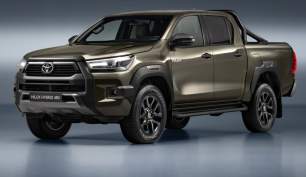Look closely and quite a lot has changed. This is really a story of doing a facelift right. Lexus has kept all the great-looking bits of the car that launched in 2013, like its striking side profile and angular accents, while dumping most of its least popular elements like the spidery front light-clusters and busy front splitter, in favour of something more refined and conservative.
It even adds some new flair in the rear three-quarter, with dramatic LED light-clusters working their way into a trendy highlight strip across the boot lid.
These changes all add up for a much tougher, sportier, and nuanced design compared to the outgoing car. One that manages to make an eight-year old design look as contemporary as ever.
I even liked our test car in its plain black shade, although I'm less sure about those conservative-to-a-fault, almost Camry-esque alloy wheels.
On the inside, sadly not a whole lot has changed. The busy design looked dated when this generation of IS launched in 2013, and it still looks dated now.
The visual assault of buttons, toggles, displays, textures, and trims is a lot to take in, and makes the cabin feel smaller than it is.
It probably didn’t help the sensory overload of this car’s interior as I hopped out of the stripped-back interior in the Tesla Model 3 I had the week before.
My less-than-impressed brother, a student of design, described the IS’s interior best when he told me “It’s a bit maximalist, don’t you think?”
If nothing else, at least Lexus hasn’t blatantly imitated anyone else when it comes to its interior, but the brand remains firm on dorky design items like the laptop touchpad, redundant drive-select dial, and odd vacant panels under the climate unit which do it no favours.
A welcome upgrade for the 2021 model year is the new media screen, a highlight piece perched atop the dash. It’s bright, has excellent contrast, and doesn’t seem to fall victim to glare.
The Apple CarPlay support I used was seamless and sharp and made the most of the available real-estate in its widescreen layout.
I somehow didn’t mind that the instrument cluster in this base car is analog. It almost suits the IS’s character better than a digital set-up would. Also offered is a small information display between the dials which I used for monitoring the hybrid drive.
A final note on the IS’s design. The fit and finish is quality, inside and out. It leaves you with an impression that this is an immaculately built vehicle, one that should be a must for all luxury cars, and always a strong point for Lexus.

